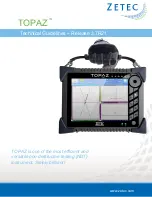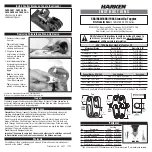
AKD-20 AR / Entellisys AR Low-voltage Switchgear
DEH-41473
Section 10. Maintaining the Switchgear
61
©2016 General Electric. All rights reserved.
Checks after Circuit Breaker is De-Energized
At the time of inspection, the following checks should be
made after the breaker has been de-energized.
1.
Manually operate the breaker several times, checking
for obstructions or excessive friction. Manual closing
of an electrically operated breaker may be
performed by the following two steps:
a.
To charge the mechanism springs, pull the
operating handle down until it stops (about
90°) ten times for the EntelliGuard breaker.
The charge indicator will show CHARGED on
a yellow background.
b.
Depress the CLOSE button on the front of the
breaker. The springs should discharge and,
if the latch is properly reset, the breaker will
close.
2.
Electrically operate the breaker several times to
check performance of the electrical accessories.
3.
Visually check the breaker for loose hardware on the
breaker; also, check the bottom of the compartment
for any hardware that has fallen from the breaker.
4.
Remove and inspect the arc quenchers and contacts
for breakage or excessive burning.
5.
The performance of the solid-state current trip
devices may be checked with a suitable test set.
Check electro-mechanical devices for positive trip in
accordance with the instructions in the proper
instruction manual.
6.
Check insulating parts for evidence of overheating
and for cracks that indicate excessive thermal aging.
Refer to circuit breaker instruction manuals for detailed
maintenance instructions and information for replacement of
parts. See DEH-41304 (AKD-20 AR Only) or DEH-41526
(Entellisys AR Only).
Lubrication
In general, the circuit breaker requires moderate lubrication.
Bearing points and sliding surfaces should be lubricated at
the regular inspection periods with a thin film of GE lubricant
D6A15A2. Before lubricating, remove any hardened grease
and dirt from latch and bearing surfaces with mineral spirits
then wipe with a clean rag.
On draw-out breakers, the contact surface of the disconnect
fingers should be cleaned and greased with GE lubricant
D6A15A2.
NOTICE: All excess lubricant should be removed with a clean
cloth to avoid accumulation of dirt or dust.
Instruments, Instrument Transformers, and Relays
DANGER: Electrical arc flash hazard. Personal
protection equipment required. Turn off power to the
equipment before working inside.
WARNING: De-energize the equipment completely
before doing maintenance work on any devices,
connections, bus work, breaker or feeder cable
compartments. This includes de-energizing any
connections to outside primary or secondary sources, such
as transformers, tie lines, etc.
Check and inspect all devices to see that they are functioning
properly. Check that all electrical connections are tight.
Check mounting of the device.
Under normal conditions, the protective relays do not
operate; therefore, it is important to check the operation of
these devices regularly. Refer to relay instruction manuals for
detailed instructions.
Circuit Breaker Compartment Interiors
DANGER: Electrical arc flash hazard. Personal
protection equipment required. Turn off power to the
equipment before working inside.
WARNING: De-energize the equipment completely
before doing maintenance work on any devices,
connections, bus work, breaker or feeder cable
compartments. This includes de-energizing any
connections to outside primary or secondary sources, such
as transformers, tie lines, etc.
Thoroughly clean the interior of the breaker and instrument
compartments. Use a vacuum cleaner and clean rags only.
Do not use steel wool or oxide papers. Blowing with
compressed air is not recommended.
Check indicating devices, mechanical and key interlocks.
Check primary disconnecting device contacts for signs of
abnormal wear or overheating. Discoloration of the silvered
surfaces is not ordinarily harmful. These contacts should be
cleaned only by wiping with a lint-free cloth.
Clean the racking mechanism and lubricate with GE lubricant
D6A15A2.
Before replacing the breaker, wipe off the primary
disconnecting device contacts. Apply a thin coat of GE
lubricant D6A15A2 to the stationary studs and to the primary
disconnects on the breaker.
















































